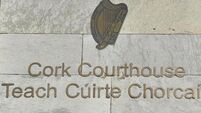Caution as spring arrives

When I go out into the garden there’s an almost deafening chorus of young lambs looking for their mothers in the surrounding fields.
There’s a pair of butterflies circling each other in a mating dance — too far away to see what species they are.
At dawn and dusk there’s a mounting chorus of bird song. Every time the sun comes out the verges of the lane suddenly light up with the gold of lesser celandines opening their flowers to bask in it.
Spring has definitely arrived in the cold corner of the country that I live in.
It’s an inspiring season of the year.
It has certainly inspired countless poets and musicians over the centuries and it’s also inspiring for gardeners.
But it’s easy to get a bit carried away by all this inspiration.
When I started learning about gardening one of my biggest mistakes was to sow seeds or young plants too early, and I suspect I’m not alone in this.
Soil temperature lags way behind the daytime air temperature.
You can check this scientifically by using a soil thermometer or do it the old-fashioned by by sticking your hand into the ground.
So my seed potatoes are still in their chitting trays in a frost-free shed.
I no longer make the mistake of planting them in mid March and suffering the setback of having the tender young shoots appear above ground to be burned black by late frosts.
The only seeds I have sown — broad beans, scallions and some herbs, are still in pots in the greenhouse and I have a small electric heater controlled by a thermostat to protect them.
I have found that if you exercise this sort of caution you actually end up with earlier crops and heavier yields.
The only outdoor work I’m doing in the vegetable garden is digging and weeding, preparing the beds for that day, still a few weeks off, when I judge it’s safe to bring hardier plants like broad beans and peas out of the cosseted shelter of the greenhouse into the big, bad world.
Tender things like courgettes and French beans won’t go out until around the third week of May.
If your garden is in a sheltered spot in south Kerry this will all sound a bit strange to you.
But mine is in the cold Midlands.
Holding back on the garden work does allow me a bit more time to appreciate what’s going on in the wild.
I can walk down the lane and part the old, brown fronds of the harts’ tongue ferns and find the pale green and silver of the new shoots, coiled like springs waiting to be released.
I also find violets and primroses in flower and flower buds waiting to open on the wild strawberries.
Birds of many shapes and sizes are carrying clumsy pieces of nest material in their beaks.
A wood pigeon is constructing a flimsy platform of twigs in a hawthorn.














